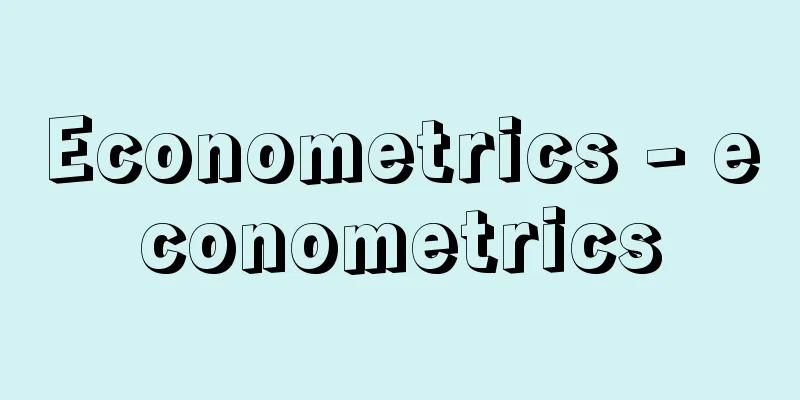Econometrics - econometrics

|
It is a field of modern economics that lies between economic theory and the real economy, and aims to grasp the causal relationships between the economic elements behind economic phenomena as quantitative models, infer their specific structure based on actual economic data, and thereby analyze and predict the real economy, contributing to the formulation of business plans and economic policies, as well as promoting the further development of economic theory. [Tadashi Takashima] Relationship with economic theoryEconometrics expresses the economic causal relationships behind real economic movements as a quantitative model, so in order for it to function adequately for prediction and analysis purposes, the model must be based on established economic theories. On the other hand, since economic phenomena represent the economic aspects of human behavior, unlike natural phenomena, their laws tend to change over time. Therefore, established economic theories must be constantly revised in comparison with the real economy, and new theories must be formed. To do this, it is necessary to verify the validity of established economic theories and new theories that are still in the hypothesis stage based on economic statistics obtained by observing real economic movements. Econometrics fulfills this role, and in that sense it can be said to be a key academic field in the entire system of economics. [Tadashi Takashima] historySince Adam Smith and neoclassical theory, economics has enriched its theoretical content, but since the 1910s, work has been done to give quantitative meaning to the content of this qualitative pure theory based on observations of the real economy, or to statistically verify it. Initially, econometric research was started by H. L. Moore, H. Schultz, R. A. K. Frisch, and others in the field of statistical measurement of demand elasticity, demand function, supply function, etc. for specific goods, but eventually the Econometric Society was founded in the United States in 1930 by J. A. Schumpeter, I. Fisher, and others with the aim of combining the results of theoretical economics with the methods of inferential statistics to give quantitative content to economic theory. After that, much effort was devoted to research into statistical estimation methods, particularly in econometric methodology, and the methodological foundations were established to a certain extent, centered around the Cowles Commission, an American research group whose members included T.C. Koopmans, T. Haubermo, W.C. Hood, and J. Marschak. [Tadashi Takashima] Research ProceduresEconometric research is carried out according to the following procedure. First, (1) based on the results of previous economic theories, the economic phenomenon to be measured is understood as a causal relationship between the various economic factors behind it, and this is expressed as a quantitative model that also takes into account stochastic fluctuation factors (model construction), (2) using data obtained by observing the real economy for each economic factor, parameters that give the quantitative model a concrete quantitative expression are estimated (structural equation estimation), and (3) the results of inferential statistics (mathematical statistics) are applied to statistically verify the validity of the model that was initially set up (hypothesis testing). Depending on the results, (4) the model is revised or reconstructed by introducing new economic theories, and the procedure from (2) onwards is repeated until a structural equation that is satisfactory in economic theory and statistical theory is obtained (structural equation determination). This allows the fluctuation mechanism of the real economy to be grasped as an econometric model with a concrete, quantitative expression, and (5) tasks such as analysis of economic fluctuations, future forecasts, and planning are carried out based on the model (structural equation system). [Tadashi Takashima] Model FormSuch econometric research can be broadly divided into two types based on the type of model constructed. One is the single equation model, which is used when studying the fluctuation mechanism of a specific part of the economy in isolation from other parts. For example, it is often used to estimate the production function or forecast demand for a specific good, and is a research method that generally corresponds to partial equilibrium analysis in economic theory. In contrast, econometric research using simultaneous equation models corresponds to general equilibrium analysis in economic theory. Essentially, any economic phenomenon occurs when each economic element in the entire economic system has an interdependent relationship, and a simultaneous equation model explicitly expresses the causal relationship of such interdependence. In this case, the movement of a specific economic element is quantitatively grasped within the interdependence of the entire economy. [Tadashi Takashima] Estimation methodThere are various estimation methods for obtaining structural equations as concrete quantitative expressions of the relationships established as a model. The core of the estimation method problem is to estimate parameters as close as possible to the true values from given data on economic variables, and therefore to find parameter estimates with the most desirable statistical properties corresponding to a given model. The least squares method is generally used to estimate single-equation models, but when this is applied to coupled systems, it results in biased estimates. To avoid this drawback, several methods have been devised, including the two-stage least squares method and the maximum likelihood method. [Tadashi Takashima] "Introduction to Econometrics, by Fukuchi Takao (1963, Toyo Keizai Shinposha)" ▽ "Theory of Econometrics, by A.S. Goldberger, translated by Fukuchi Takao and Moriguchi Shinji (1972, Toyo Keizai Shinposha)" ▽ "Methods of Econometrics, by J. Johnston, translated by Takeuchi Hiroshi et al., revised edition in two volumes (1976, Toyo Keizai Shinposha)" ▽ "Econometrics, by Tsujimura Etaro (2008, Iwanami Shoten)" ▽ "Introduction to Econometrics, by Miyagawa Kimio (Nikkei Bunko)" [References] | | | | | | | | | | | | | |Source: Shogakukan Encyclopedia Nipponica About Encyclopedia Nipponica Information | Legend |
|
経済理論と現実経済の間にあって、経済現象の背後にある経済諸要素間の因果関係を数量モデルとして把握し、実際の経済データに基づいてその具体的な構造を推定し、それによって現実経済の分析や予測を行い、経営計画や経済政策の立案に資するほか、経済理論のいっそうの発展を促すことを目的とする近代経済学の一分野である。 [高島 忠] 経済理論との関係計量経済学は、現実の経済の動きの背後にある経済的因果関係を数量モデルとして表現するものであるから、それが予測や分析目的に十分に機能するためには、これまでに確立された経済理論に立脚してモデルの設定が行われなければならない。一方、経済現象は人間行動の経済的側面を表すものであるから、自然現象とは異なり、その法則性も歴史とともに変化する性格をもつ。したがって、確立された経済理論も絶えず現実経済との対照のうちに修正され、新理論の形成が行われなければならない。そのためには、確立された経済理論やまだ仮説の段階にある新理論を、現実経済の動きを観測して得られる経済統計資料に基づいて、その有効性を検証することが必要となる。その役割を果たすものが計量経済学であり、その意味では、経済学全体系のなかで要(かなめ)に位置する学問分野といいうる。 [高島 忠] 歴史アダム・スミス以来、新古典派の理論を経て、経済学はその理論的内容を豊かにしていったが、その定性的純粋理論の内容に、現実経済の観測に基づいて定量的意味づけを与え、あるいはそれを統計的に検証しようとする仕事が1910年代からおこった。当初は、特定財に関する需要弾力性や需要関数、供給関数などの統計的計測という分野で、H・L・ムーア、H・シュルツ、R・A・K・フリッシュらによって計量経済学的研究が開始されたが、やがて理論経済学の成果と推測統計学の手法を結合して経済理論に数量的内容を与えることを目的として、1930年にJ・A・シュンペーター、I・フィッシャーらによってアメリカに計量経済学会が設立された。その後は、とくに計量経済学の方法論の統計的推定法の研究に力が注がれ、T・C・クープマンス、T・ホーベルモ、W・C・フード、J・マルシャックらをメンバーとするアメリカの研究グループ、コールズ・コミッションCowles Commissionを中心として、その方法論的基礎はいちおうの確立をみるに至った。 [高島 忠] 研究手続計量経済学の研究は、次の手続に従って行われる。まず、(1)これまでの経済理論の成果に立脚しながら、計測の対象とする経済現象をその背景にある経済諸要素間の因果関係としてとらえ、それを確率的変動要素をも考慮した数量モデルとして表現し(モデルの構築)、(2)各経済要素について、現実経済を観測して得られたデータを用いて、その数量モデルに具体的な数量的表現を与えるパラメーターを推定し(構造方程式の推定)、(3)推測統計学(数理統計学)の成果を応用して、当初に設定したモデルの妥当性を統計的に検証する(仮説検定)。その結果によっては、(4)モデルを修正し、あるいは新たな経済理論の導入によってモデルの再構築を行ったうえで、(2)以降の手続を、経済理論上および統計理論上、満足すべき構造方程式が得られるまで繰り返す(構造方程式の確定)。これによって、現実経済の変動メカニズムが具体的、数量的表現をもつ計量経済モデルとして把握されたことになるから、(5)そのモデル(構造方程式体系)に基づいて経済変動の分析、将来予測、計画策定などの作業が行われることになる。 [高島 忠] モデルの形態このような計量経済学的研究は、構築されるモデルの形態から二つに大別される。一つは単一方程式モデルであって、これは経済のある特定部分の変動メカニズムをそれ以外の部分から切り離して研究しようとする際に用いられる。たとえば、ある特定財についての生産関数の推定や需要予測などを行うのに用いられることが多く、一般に経済理論のなかでは部分均衡分析に対応する研究方法である。これに対して、経済理論における一般均衡分析に対応するものは、連立方程式モデルによる計量経済学研究である。本来、どのような経済現象も、一般に全経済体系のなかで各経済要素が相互依存の関係をもちながら発生するものであり、連立方程式モデルはそのような相互依存の因果関係を明示的に表現するものである。ここにおいては、特定の経済要素の動きも経済全体の相互依存のなかで数量的に把握されることになる。 [高島 忠] 推定方法モデルとして設定された関係式について、その具体的な数量的表現としての構造方程式を得るには種々の推定方法がある。推定方法の問題の核心は、経済変数に関する所与のデータから、できる限り真の値に近接した値としてパラメーターを推定することにあり、したがって、所与のモデルに対応してもっとも望ましい統計的性質をもったパラメーター推定量をみいだすことにある。単一方程式モデルの推定には一般に最小二乗法が用いられるが、これを連立体系に適用すれば偏りのある推定値となる。その欠点を回避するため、二段階最小二乗法や最尤(さいゆう)法などいくつかの手法が考え出されている。 [高島 忠] 『福地崇生著『計量経済学入門』(1963・東洋経済新報社)』▽『A・S・ゴールドバーガー著、福地崇生・森口親司訳『計量経済学の理論』(1972・東洋経済新報社)』▽『J・ジョンストン著、竹内啓他訳『計量経済学の方法』全訂版全2巻(1976・東洋経済新報社)』▽『辻村江太郎著『計量経済学』(2008・岩波書店)』▽『宮川公男著『計量経済学入門』(日経文庫)』 [参照項目] | | | | | | | | | | | | | |出典 小学館 日本大百科全書(ニッポニカ)日本大百科全書(ニッポニカ)について 情報 | 凡例 |
<<: Econometric model - econometric model
Recommend
Tawfīq al‐Ḥakīm
1902‐1987 One of Egypt's three greatest writer...
St. Mark's Basilica - St. Mark's Basilica (English spelling)
A Byzantine-Romanesque cathedral representing Veni...
"Fishing Village Night Tales" - Gyoson Yawa
…He invented observation equipment such as the Ki...
Secretarybird (snake-eating eagle) - Secretarybird (English spelling)
A bird of the family Secretarybird (illustration) ...
Youth movement
A youth-centered movement, or an organized movemen...
Kapuzinerberg - Kapuzinerberg
…A designated city and archbishopric. The Salzach...
Pokey-hokey (English spelling)
...They like children and horses, and are believe...
Capital Debate - Shihonronso
Production that is possible only if there is an ac...
Large-leaved horsetail - Large-leaved horsetail
A woody climbing plant of the Aristolochiaceae fa...
Sales tax - Uriagezei (English spelling) sales tax
This is a tax levied based on the transaction vol...
baccalarius
...On the other hand, the term bachelor originall...
Alchemilla japonica (alchemilla japonica)
A perennial plant of the Rosaceae family that rare...
Ploceus cucullatus (English spelling) Ploceuscucullatus
…Sexual relations for reproduction vary from mono...
summer squash
…(2) Western pumpkin C. maxima Duch. (English nam...
Grand Duchy of Vladimir (Vladimiro‐Suzdal'skoe knyazhestvo)
A principality in medieval Russia. When Kievan Rus...









